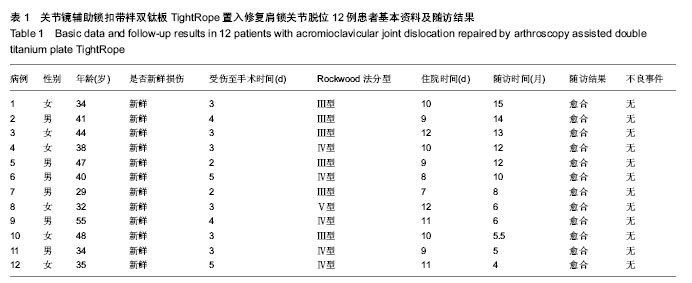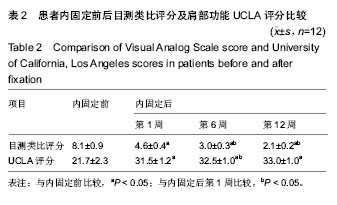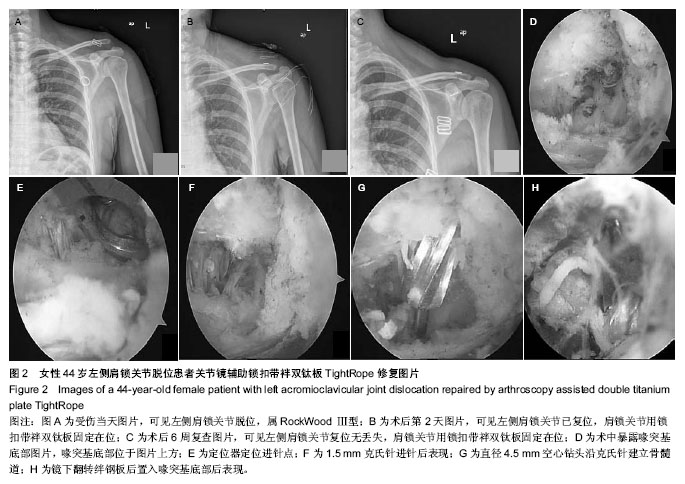| [1] 孙建华,闫安,王鹏程.肩锁关节脱位不同手术方法疗效的病例对照研究[J].中国骨伤,2011,42(3):208-211.
[2] 王光勇,张建华,周永焕,等.RockwoodⅢ型肩锁关节脱位治疗的比较研究[J].实用医学杂志,2012,28(22):3810-3812.
[3] 郑玉晨,姜洪丰,王敬博,等.两种术式治疗Rockwood m型肩锁关节脱位效果的对比研究[J].哈尔滨医科大学学报,2012,46(01): 66-69.
[4] 李中正,王林,赵捷,等. 双Endobutton技术重建喙锁韧带治疗TossyⅢ型肩锁关节脱位疗效观察[J]. 现代实用医学, 2011, 23(21):94-95.
[5] 俞航,黄洪,陈明亮,等.双Endobutton技术重建喙锁韧带治疗RockwoodⅢ-V型肩锁关节脱位[J].中国骨与关节损伤杂志, 2014,29(7):681-682.
[6] 王斌,高益,沈鹏飞,等.改良双Endobutton钢板技术治疗Tossy m型肩锁关节脱位[J].实用医学杂志,2014,30(2):222-224.
[7] 王国文,廖卫华,董谢平.半腱肌肌腱移植重建喙锁韧带加钩钢板固定治疗肩锁关节Ⅲ度脱位的临床应用[J].江西医药,2011, 46(10):905-906.
[8] 杨树龙,杜胜利.同种异体肌腱重建喙锁韧带治疗TossyⅢ型肩锁关节脱位[J].中外医学研究,2011,9(13):34-35.
[9] 王宣生,张旭强,李庆泰,等.同种异体肌腱在肌腱缺损治疗的临床应用[J].现代临床医学,2006,32(6): 422- 423.
[10] 陈刚,龚遂良,范国明,等.双带袢内置纽扣钢板重建固定技术治疗完全性肩锁关节脱位10例[J].中华创伤杂志,2010,26(5): 446-448.
[11] 毛小成,赵枫,曹杰,等.LARS人工韧带重建喙锁韧带治疗肩锁关节脱位[J].中国骨与关节损伤杂志,2011,26(1):64-65.
[12] 刘斌,刘建军.锁骨钩钢板内固定并喙锁韧带重建术治疗Tossy III型肩锁关节脱位(附26例报告)[J].山东医药,2011,51(50):72-73.
[13] 杨林平.掌长肌腱重建喙锁韧带联合锁骨钩钢板固定治疗肩锁关节脱位[J].现代中西医结合杂志,2012,21(28):3146-3147.
[14] 郑继会,付中国,苑娜,等.锁骨钩钢板固定结合喙锁韧带重建治疗陈旧性肩锁关节脱位[J].中国修复重建外科杂志,2010,24(6): 761-762.
[15] 黄克坚,孙辉,高立华,等.改良喙肩韧带移位重建结合双Endobutton钢板治疗Ⅲ型肩锁关节脱位的临床观察[J].中华关节外科杂志:电子版,2011,5(2):170-174.
[16] 叶晖,林其仁,王文怀,等.同种异体肌腱结合锚钉重建喙锁韧带治疗急性肩锁关节脱位[J]. 中华手外科杂志,2014,30(4):265-267.
[17] 彭权亮,朱伟民,欧阳侃,等.关节镜下TightRope绊钢板治疗肩锁关节脱位[J].中国临床解剖学杂志,2012,30(4):459-461.
[18] 吕书军,曹勇,周广鉴,等.三重固定纽扣钢板肩锁关节复位的生物力学[J]. 中国组织工程研究与临床康复,2011,15(9):1675-1679.
[19] 陆叶,陈云丰.肩锁关节脱位手术治疗中修复重建方式及修复材料的临床应用研究与进展[J].中国组织工程研究与临床康复, 2009,13(42):8341-8345.
[20] 陆男吉,王建华,张长青,等.锁骨钩钢板治疗急性肩锁关节脱位或锁骨远端骨折[J].中华手外科杂志,2004,20(2):87-89.
[21] Koukakis A,Manouras A,Apostolou CD,et alResults using the AO hook plate for dislocations of acromioclavicular jiont. Excep Rev Med Devies.2008;5(5):567-572.
[22] Weaver JK,Dunn HK.Treament of Acromioclavicular injuries,especially completee acromioclavicular separation. J Bone Jiont Surg(Am).1972;54:1187-1194.
[23] Moinfar AR,Murthi AM.Anatomy of the pectoralis mionr tendon and its use in acromioclavicuar jiont reconstruction.J Shoulder Elbow Surg.2007;16:339-346.
[24] Deshukh AV,Wilson DR,Zilberfarb JL,et al.Stablitity of acromioclavicuar jiont reconstruction:biomechanical testing of various surgial techniques in a cadaveric model.Am J Sports Med.2004;32:1492-1498.
[25] Struhl S. Double endobutton technique for repair of complete acrmiocalvicular jiont dislocations. Tech Shoulder Elbow Surg. 2007:294-299.
[26] 刘焱,崔志明,崔胜宇,等.微创喙锁韧带重建与锁骨钩钢板置入内固定治疗TosssyⅢ型肩锁关节脱位:功能恢复的对照研究[J].中国组织工程研究与临床康复,2011,15(39):7336-7339.
[27] 杨树龙,杜胜利.同种异体肌腱重建喙锁韧带治疗TossyⅢ型肩锁关节脱位[J].中外医学研究,2011,9(13):34-35.
[28] 王金军,刘康,余新平,等.AC TightRope钢板重建喙锁韧带治疗肩锁关节脱位[J].实用骨科杂志,2013,19(6):349-352.
[29] 赵立连,张耀南,尹自龙,等.全关节镜下双纽扣钢板固定技术治疗急性肩锁关节脱位的初步临床疗效观察[J].中华关节外科杂志(电子版),2010,4(1):11-14.
[30] 龚晓峰,姜春岩,王满宜.肩锁关节脱位的诊断与治疗[J]. 中华骨科杂杂,2005,25(4): 241-243.
[31] Struhl S. Double endobutton tenchnique for repair of compelte acromioclaicular joint dislocations. Tech Shoulder Elbow Surg. 2007;8(4):175-179.
[32] LimYW,Sood A,Riet RP,et al.Acromio-clavicular joint reduction, repair and reconstruction using metallic buttons early results and complications. Tech Shoulder Elbow Surg. 2007;8:213-221. |



.jpg)